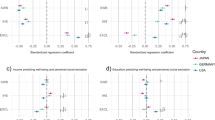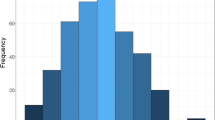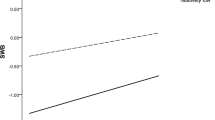Abstract
Background
Recently, researchers have proposed that psychological resources might be key concept in explaining the association between social class and health. However, empirical examinations of the extent to which psychological resources to social class in health are still few.
Purpose
This study investigated mediating effects of selected psychological resources (sense of control, self-esteem, optimism, and neuroticism) on the association of social class [education and subjective social status (SSS)] with current health status (self-rated health and the number of chronic conditions).
Method
This sample consisted of 1,805 Americans (818 males and 987 females) from the Midlife in the United States (MIDUS) survey, 2004–2006 and 1,027 Japanese (505 males and 522 females) from the Midlife in Japan (MIDJA) survey in Tokyo, Japan, 2008–2010. Information on social class, psychological resources, and health status was obtained using telephone interviews or written questionnaires.
Results
A mediation analysis was conducted separately for males and females in Japan and the USA. Neuroticism significantly mediated the association of education and SSS with self-rated health and chronic conditions among males and females in both countries, with one exception (not for chronic conditions among Japanese females). Sense of control significantly mediated the association of education and SSS with self-rated health among males and females in both countries. As hypothesized, self-esteem significantly mediated almost all of the associations of education and SSS with self-rated health and chronic conditions among men and women in the USA, but very few such associations in Japan. Optimism significantly mediated most associations of social class and health status in both countries, but only among females.
Conclusions
Overall, the findings underscore important culture- and gender specificity in the ways in which psychosocial resources mediate the links between social class and health.

Similar content being viewed by others
References
Adler NE, Rehkopf DH. U.S. disparities in health: descriptions, causes, and mechanisms. Annu Rev Public Health. 2008;29:235–52. doi:10.1146/annurev.publhealth.29.020907.090852.
Prus SG. Comparing social determinants of self-rated health across the United States and Canada. Soc Sci Med. 2011;73(1):50–9. doi:10.1016/j.socscimed.2011.04.010.
Lorant V, Deliege D, Eaton W, Robert A, Philippot P, Ansseau M. Socioeconomic inequalities in depression: a meta-analysis. Am J Epidemiol. 2003;157(2):98–112.
Kagamimori S, Gaina A, Nasermoaddeli A. Socioeconomic status and health in the Japanese population. Soc Sci Med. 2009;68(12):2152–60. doi:10.1016/j.socscimed.2009.03.030.
Cohen S, Alper CM, Doyle WJ, Adler N, Treanor JJ, Turner RB. Objective and subjective socioeconomic status and susceptibility to the common cold. Heal Psychol. 2008;27(2):268–74. doi:10.1037/0278-6133.27.2.268.
Kopp M, Skrabski A, Rethelyi J, Kawachi I, Adler NE. Self-rated health, subjective social status, and middle-aged mortality in a changing society. Behav Med. 2004;30(2):65–70. doi:10.3200/bmed.30.2.65-72.
Singh-Manoux A, Marmot MG, Adler NE. Does subjective social status predict health and change in health status better than objective status? Psychosom Med. 2005;67(6):855–61. doi:10.1097/01.psy.0000188434.52941.a0.
Sakurai K, Kawakami N, Yamaoka K, Ishikawa H, Hashimoto H. The impact of subjective and objective social status on psychological distress among men and women in Japan. Soc Sci Med. 2010;70(11):1832–9. doi:10.1016/j.socscimed.2010.01.019.
Schnittker J. Psychological factors as mechanisms for socioeconomic disparities in health: a critical appraisal of four common factors. Soc Biol. 2004;51(1–2):1–23.
Bosma H, Schrijvers C, Mackenbach JP. Socioeconomic inequalities in mortality and importance of perceived control: cohort study. Br Med J. 1999;319(7223):1469–70.
Bosma H, Van Jaarsveld CH, Tuinstra J, et al. Low control beliefs, classical coronary risk factors, and socio-economic differences in heart disease in older persons. Soc Sci Med. 2005;60(4):737–45. doi:10.1016/j.socscimed.2004.06.018.
Gallo LC, de los Monteros KE, Ferent V, Urbina J, Talavera G. Education, psychosocial resources, and metabolic syndrome variables in Latinas. Ann Behav Med. 2007;34(1):14–25. doi:10.1080/08836610701495532.
Matthews KA, Raikkonen K, Gallo L, Kuller LH. Association between socioeconomic status and metabolic syndrome in women: testing the reserve capacity model. Heal Psychol. 2008;27(5):576–83. doi:10.1037/0278-6133.27.5.576.
Gallo LC, Bogart LM, Vranceanu AM, Matthews KA. Socioeconomic status, resources, psychological experiences, and emotional responses: a test of the reserve capacity model. J Personal Soc Psychol. 2005;88(2):386–99.
Gallo LC, Matthews KA. Understanding the association between socioeconomic status and physical health: do negative emotions play a role? Psychol Bull. 2003;129(1):10–51.
Matthews KA, Gallo LC, Taylor SE. Are psychosocial factors mediators of socioeconomic status and health connections? A progress report and blueprint for the future. Ann N Y Acad Sci. 2010;1186:146–73. doi:10.1111/j.1749-6632.2009.05332.x.
Rosenberg M. Society and the adolescent self-image. Princeton: Princeton University Press; 1965.
Lachman ME, Firth KMP. The adaptive value of feeling in control during midlife. In: Brim OG, Ryff CD, Kessler RC, editors. How healthy are we?: a national study of well-being at midlife. Chicago: University of Chicago Press; 2004. p. 320–49.
Tellegen A. Structures of mood and personality and their relevance to assessing anxiety, with an emphasis on self-report. In: Tuma AH, Maser JD, editors. Anxiety and the anxiety disorders. Hillsdale: Lawrence Erlbaum Associates, Inc; 1985. p. 681–706.
Scheier MF, Carver CS. Optimism, coping, and health: assessment and implications of generalized outcome expectancies. Heal Psychol. 1985;4(3):219–47.
Finkelstein DM, Kubzansky LD, Capitman J, Goodman E. Socioeconomic differences in adolescent stress: the role of psychological resources. J Adolesc Heal. 2007;40(2):127–34. doi:10.1016/j.jadohealth.2006.10.006.
Markus HR, Kitayama S. Culture and the self: implications for cognition, emotion, and motivation. Psychol Rev. 1991;98(2):224–53. doi:10.1037/0033-295x.98.2.224.
Kitayama S, Markus HR, Matsumoto H, Norasakkunkit V. Individual and collective processes in the construction of the self: self-enhancement in the United States and self-criticism in Japan. J Personal Soc Psychol. 1997;72(6):1245–67.
Diener E, Diener M. Cross-cultural correlates of life satisfaction and self-esteem. J Personal Soc Psychol. 1995;68(4):653–63.
Kitayama S, Karasawa M, Curhan KB, Ryff CD, Markus HR. Independence and interdependence predict health and wellbeing: divergent patterns in the United States and Japan. Front Psychol. 2010;1:163. doi:10.3389/fpsyg.2010.00163.
Adler NE, Epel ES, Castellazzo G, Ickovics JR. Relationship of subjective and objective social status with psychological and physiological functioning: preliminary data in healthy white women. Heal Psychol. 2000;19(6):586–92.
Prenda KM, Lachman ME. Planning for the future: a life management strategy for increasing control and life satisfaction in adulthood. Psychol Aging. 2001;16(2):206–16. doi:10.1037/0882-7974.16.2.206.
Lachman ME, Weaver SL. The sense of control as a moderator of social class differences in health and well-being. J Personal Soc Psychol. 1998;74(3):763–73.
Prenda KM, Lachman ME. Planning for the future: a life management strategy for increasing control and life satisfaction in adulthood. Psychol Aging. 2001;16(2):206–16.
Lachman ME, Weaver SL. The Midlife Development Inventory (MIDI) Personality Scales: scale construction and scoring. Technical Report No. 1. Waltham: Brandeis University; 1997. p. 23.
Scheier MF, Carver CS, Bridges MW. Distinguishing optimism from neuroticism (and trait anxiety, self-mastery, and self-esteem): a revaluation of the Life Orientation Test. J Personal Soc Psychol. 1994;67(6):1063–78. doi:10.1037/0022-3514.67.6.1063.
Preacher KJ, Hayes AF. SPSS and SAS procedures for estimating indirect effects in simple mediation models. Behav Res Methods Instrum Comput. 2004;36(4):717–31.
Preacher KJ, Hayes AF. Asymptotic and resampling strategies for assessing and comparing indirect effects in multiple mediator models. Behav Res Methods. 2008;40(3):879–91.
MacKinnon DP, Lockwood CM, Hoffman JM, West SG, Sheets V. A comparison of methods to test mediation and other intervening variable effects. Psychol Methods. 2002;7(1):83–104.
Sumi K. Optimism, social support, stress, and physical and psychological well-being in Japanese women. Psychol Rep. 1997;81(1):299–306.
Bowling A. Gender-specific and gender-sensitive associations with psychological health and morbidity in older age. Baseline findings from a British population survey of ageing. Aging Mental Health. 2007;11(3):301–9. doi:10.1080/13607860600963752.
Gustavsson-Lilius M, Julkunen J, Hietanen P. Quality of life in cancer patients: the role of optimism, hopelessness, and partner support. Qual Life Res. 2007;16(1):75–87. doi:10.1007/s11136-006-9101-4.
Mosing MA, Zietsch BP, Shekar SN, Wright MJ, Martin NG. Genetic and environmental influences on optimism and its relationship to mental and self-rated health: a study of aging twins. Behav Genet. 2009;39(6):597–604. doi:10.1007/s10519-009-9287-7.
Acknowledgments
This research was supported by a grant from the National Institute on Aging (5R37AG027343) to conduct a study of Midlife in Japan (MIDJA) for comparative analysis with MIDUS (Midlife in the United States, P01-AG020166). The data analysis and preparation of the manuscript was supported by a Grant-in-Aid for Scientific Research (A) 2009-2013 (No. 20240062) from the Ministry of Education, Culture, Sports, Science and Technology, Japan.
Author information
Authors and Affiliations
Corresponding author
Appendices
Appendix 1.
Pearson’s partial correlation coefficients adjusted for age and marital status among social class, psychological resources, and health outcome variables by gender among respondents in Japan and the USA
Appendix 2
Appendix 3
Appendix 4
Appendix 5
Rights and permissions
About this article
Cite this article
Kan, C., Kawakami, N., Karasawa, M. et al. Psychological Resources as Mediators of the Association Between Social Class and Health: Comparative Findings from Japan and the USA. Int.J. Behav. Med. 21, 53–65 (2014). https://doi.org/10.1007/s12529-012-9249-y
Published:
Issue Date:
DOI: https://doi.org/10.1007/s12529-012-9249-y




